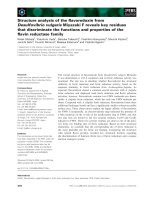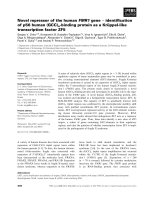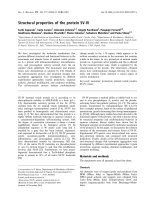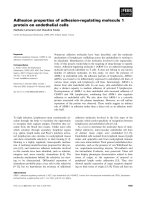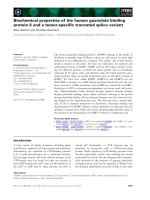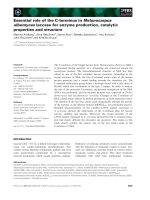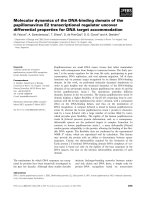Báo cáo khoa học: Biochemical properties of the human guanylate binding protein 5 and a tumor-specific truncated splice variant Mark Wehner and Christian Herrmann doc
Bạn đang xem bản rút gọn của tài liệu. Xem và tải ngay bản đầy đủ của tài liệu tại đây (328.61 KB, 9 trang )
Biochemical properties of the human guanylate binding
protein 5 and a tumor-specific truncated splice variant
Mark Wehner and Christian Herrmann
Ruhr-Universita
¨
t Bochum, Physikalische Chemie I – AG Proteininteraktionen, Universtita
¨
tsstraße 150, Bochum, Germany
Introduction
A large variety of cellular processes, including signal
transduction, regulation of transcription and membrane
deformation, are regulated by GTP-binding proteins
[1,2]. Usually these proteins act as ‘molecular switches’
that strongly interact with their effector proteins in the
GTP-bound state (‘on’ state) but only very weakly in
their GDP-bound state (‘off’ state) [3]. By hydrolysis of
the GTP to GDP and P
i
, these proteins are able to
‘switch off’ intrinsically, or GTP cleavage may be
promoted by interaction with a GTPase-activating
protein. Small regulatory GTP-binding proteins from
the Ras superfamily usually only exchange the bound
nucleotide very slowly, but the exchange rate is dramati-
cally increased in the presence of guanine nucleotide
exchange factors, and can be regulated. GTPases from
the dynamin superfamily (reviewed in [4]), on the other
Keywords
biophysics; dynamin; GTPase; guanylate
binding protein; interferons
Correspondence
C. Herrmann, Ruhr-Universita
¨
t Bochum,
Physikalische Chemie I – AG
Proteininteraktionen, Universita
¨
tsstraße 150,
44800 Bochum, Germany
Fax: +49 2343214785
Tel: +49 2343224173
E-mail:
(Received 9 October 2009, revised 15
January 2010, accepted 19 January
2010)
doi:10.1111/j.1742-4658.2010.07586.x
The human guanylate binding protein 5 (hGBP5) belongs to the family of
interferon-c-inducible large GTPases, which are well known for their high
induction by pro-inflammatory cytokines. The cellular role of this protein
family is unclear at this point, but there are indications for antiviral and
antibacterial activity of hGBP1. hGBP5 exists in three splice variants, form-
ing two different proteins, of which the tumor-specific one is C-terminally
truncated by 97 amino acids, and therefore lacks the CaaX motif for gera-
nylgeranylation. Here we present biochemical data on the splice variants of
hGBP5. We show that, unlike hGBP1, hGBP5a ⁄ b and hGBP5ta do not
bind GMP or produce any GMP during hydrolysis despite the fact the resi-
dues involved in GMP production from hGBP1 are conserved in hGBP5.
Hydrolysis of GTP is concentration-dependent and shows weak self-activa-
tion. Thermodynamic studies showed strongly negative entropic changes
during nucleotide binding, which reflect structural ordering in the protein
during nucleotide binding. These structural changes were also observed dur-
ing changes in the oligomerization state. We observed only a minor influ-
ence of the C-terminal truncation on hydrolysis, nucleotide binding and
oligomerization of hGBP5. Based on these similarities we speculate that the
missing C-terminal part, which also carries the geranylgeranylation motif, is
the reason for the dysregulation of hGBP5¢s function in lymphoma cells.
Structured digital abstract
l
MINT-7555035, MINT-7555053: hGBP5 a ⁄ b (uniprotkb:Q96PP8) and hGBP5 a ⁄ b (uni-
protkb:
Q96PP8) bind (MI:0407)bymolecular sieving (MI:0071)
l
MINT-7555028, MINT-7555044: hGBP5ta (uniprotkb:Q86TM5) and hGBP5ta (uni-
protkb:
Q86TM5) bind (MI:0407)bymolecular sieving (MI:0071)
Abbreviations
GppNHp, guanosine 5¢-(b,c-imino)-triphosphate; GTPcS guanosine, 5¢-O-(c-thio)triphosphate; hGBP, human guanylate binding protein; ITC,
isothermal titration calorimetry; mant, N-methylanthraniloyl.
FEBS Journal 277 (2010) 1597–1605 ª 2010 The Authors Journal compilation ª 2010 FEBS 1597
hand, interact dynamically with the bound nucleotide,
and usually bind nucleotides in the micromolar range.
In addition to these striking differences in nucleotide
binding, these large GTPases are catalytically very
active, show self-activating GTP hydrolysis, and are
functional as oligomers rather than monomers.
Human guanylate binding protein 5 (hGBP5) belongs
to the family of interferon-c-induced p65 GTPases,
which has seven members in the human genome [5].
This family of guanylate binding proteins was origi-
nally identified by its ability to bind to immobilized
guanine nucleotides with similar affinities for GTP,
GDP and GMP [6,7]. Within this family, the best
characterized member, human guanylate binding pro-
tein 1 (hGBP1), has been shown to exhibit a unique
hydrolytic activity – cleavage of not only the c-phos-
phate but also the b-phosphate in a successive step
[8,9]. In contrast to the small regulatory GTP-binding
proteins of the Ras superfamily, hGBP1 is character-
ized by highly dynamic nucleotide binding, low affi-
nities for all three guanine nucleotides, and high, self-
activated GTPase activity, which is promoted by olig-
omerization. These features are generally conserved in
high-molecular-weight GTPases such as dynamin and
the antiviral protein, Mx. Because of similarities in
the molecular architecture of GBPs and members of
the dynamin family, GBPs are classified as a part of
the dynamin superfamily. Although their biochemical
characteristics are well understood, there is only an
incomplete picture of the cellular functions of
hGBP1. Previous studies showed an antiviral effect
against specific viruses [10,11], and an anti-Chlamydia
effect [12], inhibition of endothelial cell proliferation
[13] and their subcellular localization [14] have also
been investigated recently. Similar to the recent report
of an anti-Chlamydia effect of hGBP1, there are
indications of murine GBP5 co-localization with mem-
brane ruffles formed by invading Salmonella enterica,
and a positive regulation of pyroptosis to defend
against infection by S. enterica and possibly other
bacterial pathogens [15]. Although no other proteins
from the guanylate-binding protein family are known
to exist as more than one splice variant, hGBP5 does
exist as three splice variants, which form two different
proteins [16]. These two proteins differ with respect to
the presence or absence of the C-terminal 97 amino
acids including the C-terminal geranylgeranylation
motif. If a fold similar to that of hGBP1 is assumed,
this deletion corresponds to deletion of extended helices
12 and 13. In healthy cells, only the a ⁄ b splice variant
is expressed, but the truncated splice variant has been
detected in all melanoma and most of lymphoma cell
lines tested.
In this study, we focus on the biochemical properties
of both splice variants of hGBP5, hGBP5a ⁄ b (amino
acids 1-586) and the C-terminally truncated hGBP5ta
(amino acids 1-489), using isothermal titration calorim-
etry (ITC), concentration-dependent GTPase assays,
fluorescence titrations and analytical gel filtration.
Results and Discussion
Hydrolytic activity of hGBP5a/b and hGBP5ta
In light of previous observations for hGBP1 and other
large GTPases, we analysed the enzymatic activity of
hGBP5a ⁄ b and hGBP5ta in a concentration-dependent
manner. Various concentrations of purified hGBP5a ⁄ b
and hGBP5ta were incubated with 350 lm of GTP,
and aliquots were taken after various durations and
analysed by C18 reverse-phase HPLC. Initial rates of
GTP hydrolysis were normalized to the protein con-
centration (specific activity) and plotted against the
protein concentration (Fig. 1).
We observed weak concentration-dependent self-acti-
vation (approximately two-fold) from a basal specific
activity at low protein concentrations to maximum turn-
overs at 25 °C of 0.054 and 0.077 s
)1
for hGBP5a ⁄ b
and hGBP5ta, respectively. Increasing the temperature
from 25 °Cto37°C resulted in an approximately three-
fold increase in specific activity (see Fig. S1). Both splice
variants exhibited positive cooperativity in specific
activity, with Hill coefficients of 2.4 and 1.9 and dissoci-
ation constants (K
d
Hill
) of 4 and 2 lm for hGBP5a ⁄ b
and hGBP5ta, respectively. The proteins are very similar
in terms of their enzymatic activity, so the activity is not
affected by deletion of the C-terminal part. In contrast
Fig. 1. Initial rates of GTP hydrolysis were normalized to the pro-
tein concentration (specific activity), and plotted against the protein
concentration. Both hGBP5a ⁄ b (circles) and hGBP5ta (squares)
show an approximately two-fold self-activation of GTP hydrolysis.
Biophysical properties of hGBP5a ⁄ b and hGBP5ta M. Wehner and C. Herrmann
1598 FEBS Journal 277 (2010) 1597–1605 ª 2010 The Authors Journal compilation ª 2010 FEBS
to results obtained for hGBP1 and hGBP2 [17], we
observed absolutely no formation of GMP at any pro-
tein concentration or time, indicating a different mech-
anism of hydrolysis compared to hGBP1. To confirm
that hGBP5 does not require higher temperatures to
form GMP, we performed additional hydrolysis mea-
surements at 37 °C, but did not detect GMP formation
(see Fig. S1). As described previously [18], certain posi-
tions in the hGBP1 large GTPase domain are crucial
for the formation of GMP by hGBP1. Surprisingly,
these residues (namely R48, H74, K76, E99, K106 and
D112 in the primary sequence of hGBP1) are con-
served in the primary structure of the GTPase domain
of hGBP5, so the formation of GMP must be impaired
in an as yet unknown manner. Sequence alignments of
the large GTP-binding domains of hGBP1, hGBP2
and hGBP5 showed many substitutions specific to
hGBP5, so we cannot conclude at present which resi-
dues are responsible for the lack of GMP formation
(see Fig. S2). The similar hydrolytic activities of the
a ⁄ b and C-terminally truncated forms of hGBP5 are in
contrast to that of the analogous deletion mutant of
hGBP1 (S. Kunzelmann, Ruhr-University Bochum and
C. Herrmann, unpublished results), which resulted in a
2.5-fold increase in specific GTPase activity and
increased formation of GMP during hydrolysis.
Thermodynamics and stoichiometry of nucleotide
binding
We used ITC to investigate the thermodynamics of
nucleotide binding. Using this method, it is possible
to determine the stoichiometry, enthalpy change,
dissociation constant and thereby the change in
entropy in a single experiment. No label is required
in these experiments as the heat change of the
reaction is measured.
Using ITC, we found a 1 : 1 stoichiometry of nucle-
otide to protein with a deviation of less than 10%. We
found comparable dissociation constants for GDP and
GppNHp [guanosine 5¢-(b,c-imino)-triphosphate], with
K
d
values of 11 and 5 lm for hGBP5ta and 7.2 and
2.6 lm for hGBP5a ⁄ b, respectively. Fo r the non-hydro-
lysable analog GTPcS [guanosine 5¢-O-(c-thio)triphos-
phate], the dissociation constant is slightly higher (see
Table 1). In all experiments, nucleotide binding yielded
large exothermic peaks, with corresponding DH values
ranging from )14.7 kcalÆmol
)1
for GDP binding to
hGBP5a ⁄ b and )38.1 kcalÆmol
)1
for binding of GTPcS
to hGBP5ta. In light of the thermodynamic data and
the oligomerization behavior, we attribute the rather
pronounced negative changes in enthalpy not simply
to nucleotide binding, but to a combination of several
exothermic effects occurring at the same time, most
likely nucleotide binding and coupled oligomerization.
All nucleotide binding experiments showed a negative
change in DS, which is compensated for by the large
and negative DH value. This negative change of entropy
is most pronounced for hGBP5a ⁄ b using the GTP ana-
log GppNHp (TÆDS = )23.5 kcalÆmol
)1
) and for
hGBP5ta using GTPcS(TÆDS = )31.9 kcalÆmol
)1
).
The TÆDS values for GDP are less negative (> )10 kca-
lÆmol
)1
) for both splice variants. We attribute these pro-
nounced entropic compensations to a loss of
conformational freedom upon nucleotide binding, and,
especially when using the GTP analogs, to the forma-
tion of higher-order oligomers. In the case of hGBP1,
the entropy changes for nucleotide binding are generally
positive but less than 5 kcalÆmol
)1
. Despite the fact that
both hGBP5 and hGBP1 form oligomers in a nucleo-
tide-dependent manner, the entropic contributions of
nucleotide binding and the coupled oligomerization
show opposing signs. In the case of hGBP1, release of
water from the nucleotide binding pocket and the pro-
tein surface may counterbalance the changes in confor-
mational flexibility imposed by nucleotide binding,
while in the case of hGBP5, conformational restrictions
after nucleotide binding and oligomer formation appear
to result in strong entropic penalties.
In contrast to the findings for hGBP1 [8], we did
not observe any signals in ITC experiments when using
GMP. Neither the a ⁄ b form nor the truncated splice
variant exhibit any GMP binding in the micromolar
range (see Fig. 2 for a representative experiment). The
missing signals in our ITC experiments are not due to
a very low DH at 25 °C, but are due to the absence of
GMP binding, as confirmed by competitive fluor-
escence measurements.
Binding and dynamics of fluorescent nucleotide
analogs
To investigate the binding of fluorescent nucleotide
analogs, we used fluorescence titrations as described
Table 1. Thermodynamic parameters of nucleotide binding by
hGBP5a ⁄ b and hGBP5ta at 25 °C as measured by ITC.
Nucleotide K
d
(lM) DH (kcalÆmol
)1
) TÆDS (kcalÆmol
)1
)
hGBP5a ⁄ b
GDP 7.2 ± 0.3 )14.7 ± 0.1 )7.7 ± 0.2
GppNHp 2.6 ± 0.3 )31.3 ± 0.4 )23.5 ± 0.6
GTPcS15±3)21.4 ± 0.8 )14.9 ± 0.9
hGBP5ta
GDP 11 ± 1 )16.5 ± 0.1 )9.7 ± 0.2
GppNHp 5 ± 0.2 )25.3 ± 0.3 )18.2 ± 0.3
GTPcS26±4)38.1 ± 0.8 )31.9 ± 0.9
M. Wehner and C. Herrmann Biophysical properties of hGBP5a ⁄ b and hGBP5ta
FEBS Journal 277 (2010) 1597–1605 ª 2010 The Authors Journal compilation ª 2010 FEBS 1599
previously for hGBP1 [8,19]. When titrating increasing
amounts of hGBP5a ⁄ b or hGBP5ta with a solution
of N-methylanthraniloyl-GDP (mant-GDP) or mant-
GTPcS, an increase in fluorescence intensity was
observed, as described previously for hGBP1 [8]. The
observed approximately 3.5-fold increase in fluores-
cence is indicative of a non-solvent-accessible binding
pocket, as found in the crystal structure of hGBP1
[20,21]. Analysis of the fluorescence intensities using a
quadratic binding equation yielded the dissociation
constants summarized in Table 2. The splice variants
hGBP5a ⁄ b and hGBP5ta did not show any significant
differences in mant-nucleotide binding. The observed
dissociation constant for mant-GTPcS (11 lm)is
higher than that for mant-GDP (3 lm), which is the
converse of the tendency observed with unlabeled
nucleotides in ITC experiments (see Fig. 3). To further
confirm the lack of GMP binding by hGBP5 splice
variants as observed in the ITC experiments, we per-
formed fluorescence titrations using mant-GMP. Simi-
lar to the ITC experiments with GMP, we only
observed a small effect, i.e. a marginal increase in
mant-GMP fluorescence in the presence of 50 lm
hGBP5 (data not shown). Furthermore, we attempted
to displace bound mant-GDP using a high excess
(3000-fold) of GMP, but only observed a decrease in
fluorescence of less than 10%, indicating a much
higher dissociation constant for GMP than for mant-
GDP. In contrast, displacement of mant-GDP from
hGBP5 was efficient at low concentrations of compet-
ing GDP, GppNHp and GTPcS (data not shown).
When investigating mant-GppNHp binding to
hGBP5a ⁄ b or hGBP5ta, we found very low reaction
rate constants that were at least 100-fold smaller than
for all other nucleotides tested (data not shown).
Because of the slow reaction of mant-GppNHp and
hGBP5, fluorescence measurements were not feasible
due to long-term protein instability. Similar to these
fluorescence experiments, a rather slow return to base-
line in the ITC experiments was observed, but, without
the mant label, GppNHp binding is fast enough to
allow equilibration after each injection.
Fig. 2. Representative isothermal titration calorimetry runs using
hGBP5ta at 25 °C. hGBP5ta (150 l
M) was titrated with 2.25 mM of
nucleotide (GMP, open circles; GDP, filled squares; GppNHp, open
squares). The raw experimental data and the processed data
(including the fitted curves using a one-site binding model) are
shown in the upper and lower panels, respectively.
Table 2. Dissociation constants of mant-labeled nucleotides as
measured by fluorescence titrations.
Nucleotide K
d
hGBP5a ⁄ b
(lM) K
d
hGBP5ta
(lM)
mant-GDP 3.1 ± 0.3 3.2 ± 0.2
mant-GTPcS 11.3 ± 0.4 10.8 ± 0.4
Fig. 3. Fluorescence titration data showing similar dissociation
constants for binding of mant-GDP (hGBP5a ⁄ b, filled circles;
hGBP5ta, open circles) and for binding of mant-GTPcS (hGBP5a ⁄ b,
filled squares; hGBP5ta, open squares) to hGBP5a ⁄ b or hGBP5ta,
respectively. Relative fluorescence values are plotted against the
concentration of added protein.
Biophysical properties of hGBP5a ⁄ b and hGBP5ta M. Wehner and C. Herrmann
1600 FEBS Journal 277 (2010) 1597–1605 ª 2010 The Authors Journal compilation ª 2010 FEBS
To investigate the dynamics of nucleotide binding,
constant concentrations of the nucleotides were mixed
with increasing amounts of hGBP5a ⁄ b or hGBP5ta
(see Fig. 4 for representative data). In the case of
mant-GTP, increasing amounts of mant-GTP were
mixed with a small concentration of hGBP5a ⁄ b
or hGBP5ta to avoid fluorescence changes due to
nucleotide hydrolysis.
The association experiments for all nucleotides mea-
sured only show a single rate constant. In contrast, the
displacement experiments using mant-GTPcS revealed
two distinct rate constants for dissociation, with the
relative amplitudes of 60% for the faster process and
40% for the slower process, which is indicative of a
difference in binding dynamics of the 2¢⁄3¢-OH mant-
labeled GTPcS as the two isomers occur in approxi-
mately this ratio. We did not find any evidence for
two dissociation rates for mant-GDP (see Fig. S3).
Using hGBP5, we found rate constants that were
approximately 100-fold lower for mant-GTP and
approximately 30-fold lower for mant-GDP than those
reported for hGBP1 [9]. The association rate constants
(k
on
) for mant-GDP (0.046 lm
)1
Æs
)1
), mant-GTPcS
(0.099 lm
)1
Æs
)1
) and mant-GTP (0.014 lm
)1
Æs
)1
) were
quite similar. In contrast, we found a five-fold faster
dissociation of mant-GTPc S (1.11 s
)1
) compared to
mant-GDP (0.23 s
)1
) and mant-GTP (0.62 s
)1
). The
three-fold lower dissociation rate (k
off
) for mant-
GTPcS was comparable to that for mant-GDP, but is
not due to partial hydrolysis of the nucleotide, as veri-
fied by HPLC analysis (Table 3). We found association
rate constants for hGBP5ta with mant-GDP, mant-
GTPcS and mant-GTP of 0.066, 0.072 and
0.025 lm
)1
Æs
)1
, respectively. The dissociation rate con-
stant obtained from the intercept of the plot in Fig. 4,
parts B and C (k
intercept
off
) and the directly measured dis-
sociation rate constants from displacement experiments
Fig. 4. Nucleotide dynamics determined using stopped flow mea-
surements. (A) Representative fluorescence traces of mant-GDP
binding to hGBP5ta. The hGBP5 concentrations increase from
2.5 l
M to 25 lM from the bottom up. (B) The observed rates of
mant-GDP (filled circles) and mant-GTPcS (open circles) association
are plotted against the protein concentration. (C) Observed associa-
tion rates of mant-GTP with hGBP5a ⁄ b (open circles) or hGBP5ta
(filled circles).
Table 3. Nucleotide binding dynamics of hGBP5a ⁄ b and hGBP5ta.
The dissociation constants were calculated using the relationship
K
d
= k
off
diss
⁄ k
on
, except for mant-GTP, for which k
off
intercept
was
used.
Nucleotide k
on
(lM
)1
Æs
)1
)
k
off
intercept
(s
)1
) k
off
diss
(s
)1
) K
d
(lM)
hGBP5a ⁄ b
mant-GDP 0.046 ± 0.003 0.28 ± 0.04 0.23 ± 0.02 5.0 ± 0.8
mant-GTPcS 0.099 ± 0.003 2.08 ± 0.04 1.11 ± 0.01
a
11.2 ± 0.5
0.19 ± 0.02
b
1.9 ± 0.3
mant-GTP 0.014 ± 0.001 0.62 ± 0.01 – 44 ± 4*
hGBP5ta
mant-GDP 0.066 ± 0.004 0.13 ± 0.01 0.23 ± 0.01 3.5 ± 0.3
mant-GTPcS 0.072 ± 0.006 1.4 ± 0.1 1.15 ± 0.05
a
16 ± 2
0.20 ± 0.03
b
2.8 ± 0.7
mant-GTP 0.025 ± 0.005 0.72 ± 0.07 – 30 ± 10
*
a
Corresponding relative amplitude = 0.6.
b
Corresponding relative
amplitude = 0.4.
M. Wehner and C. Herrmann Biophysical properties of hGBP5a ⁄ b and hGBP5ta
FEBS Journal 277 (2010) 1597–1605 ª 2010 The Authors Journal compilation ª 2010 FEBS 1601
(k
diss
off
) in Fig. S3 are similar, and show a five- to
10-fold lower rate for dissociation of mant-GDP
(0.129 ⁄ 0.23 s
)1
) from hGBP5ta than for mant-GTPcS
(1.15 s
)1
), and the value for mant-GTP is between
those two values (0.7 s
)1
). Similarly, the slower dissoci-
ation rate constant for mant-GTPcS was comparable
to that for mant-GDP (see Table 3).
Oligomerization of hGBP5a/b and hGBP5ta
Large GTPases, especially of the dynamin superfamily,
are well known for their ability to oligomerize and the
resulting stimulation of their hydrolytic activity. In
particular, hGBP1 is known to form homodimers after
GppNHp binding and larger oligomers with the transi-
tion state analog GDP and aluminum fluoride (AlF
x
)
[18]. We used analytical size-exclusion chromatography
to characterize the nucleotide-dependent oligomeriza-
tion state of the protein. Protein (20 lm) was preincu-
bated with a 10-fold excess of the nucleotide for
30 min on ice prior to injection onto a Superdex 200
column equilibrated with buffer containing 200 lm of
nucleotide.
The C-terminally truncated splice variant hGBP5ta
(theoretical molecular mass 55 kDa) shows an appar-
ent molecular mass (M
app
) in the GDP-bound form of
approximately 70 kDa, most likely due to an elongated
shape of the protein. The same behavior is observed in
the presence of GDPÆAlF
x
. Because of the unexpected
observation of a monomeric protein species with both
GDP and GDP ÆAlF
x
, we tested AlF
x
binding to the
protein by adding 300 lm AlCl
3
and 10 mm NaF to a
solution containing hGBP5a ⁄ b or hGBP5ta and GTP,
and analysed GTPase activity. We observed a reduc-
tion of GTPase activity of approximately 40%. This
small inhibitory effect suggests weak binding of AlF
x
to the protein. In the GTP-bound (as well as the nucle-
otide-free) state, a M
app
of approximately 120 kDa is
observed, which probably corresponds to a dimer.
When bound to GppNHp, the M
app
of hGBP5ta is
increased to approximately 200 kDa, which corre-
sponds to a tetramer, while the presence of GTPcS
leads to an oligomer size intermediate between those
with GTP and GppNHp (see Fig. 5A). The putative
transition state hGBP5ÆGDPÆAlF
x
resembles the prod-
uct state more closely than a GTP-bound form does.
Similar to the monomeric species for the GDP-bound
state of hGBP5ta, a recent study found that dynamin
oligomers are repeatedly dissociated while GTP hydro-
lysis occurs [22].
In contrast to hGBP5ta, the hGBP5a ⁄ b splice vari-
ant does not show a monomer species in the presence
of any nucleotide. When bound to GDP or GDPÆAlF
x
,
a dimeric form is observed (taking elongated shape
into account). The size of the protein complex is only
slightly increased when nucleotide-free or in the
presence of GTP. As with hGBP5ta, the complex is
increased to the size of a tetramer after binding of
GppNHp, and binding of GTPcS again shows an
intermediate behavior (Fig. 5B). The elution profiles of
both hGBP5ta and hGBP5a ⁄ b in the presence of vari-
ous nucleotides show a small fraction of protein com-
plexes eluting at higher apparent masses. This might
be an indication that equilibria between various oligo-
mer complexes are established that are controlled by
the bound nucleotide. In contrast to hGBP1, our
observations suggest that, in the course of hGBP5 cat-
alyzed GTP hydrolysis, a nucleotide-free hGBP5 dimer
binds GTP, leading to a larger complex (represented
by GppNHp ⁄ GTPcS). GTP cleavage leads to dissocia-
tion of the protein complex shown by the apparent
A
B
Fig. 5. Size-exclusion chromatography of the splice variants
hGBP5ta (A) and hGBP5a ⁄ b (B), respectively, with various nucleo-
tides [red, GDP; green, GDPÆAlF
x
; magenta, GTP; blue, GppNHp;
cyan, GTPcS] and in the nucleotide-free state (black). The absor-
bance at 280 nm was plotted against the elution volume (V
e
)
normalized to the exclusion volume (V
0
).
Biophysical properties of hGBP5a ⁄ b and hGBP5ta M. Wehner and C. Herrmann
1602 FEBS Journal 277 (2010) 1597–1605 ª 2010 The Authors Journal compilation ª 2010 FEBS
dimer, resulting in monomeric product complex in the
case of hGBP5taÆGDP. In contrast, the hGBP5a ⁄ b
splice variant remains dimeric. This difference may be
caused by the additional amino acids at the C-terminus
of hGBP5a ⁄ b.
Concluding remarks
We observed biochemical properties for hGBP5
that are strongly different from those of the well-
characterized isoform hGBP1. The GTPase activity is
much lower, and, in particular, the concentration-
dependent activation is not as pronounced. In contrast
to hGBP1, we did not observe any GMP binding by
hGBP5, and the enzymatic hydrolysis of GTP leads to
GDP rather than GMP. The nucleotide affinities of
hGBP5 are grossly similar to those of hGBP1, but
there are differences in thermodynamic and kinetic
details. The entropy changes are more negative in the
case of hGBP5, possibly reflecting larger structural
changes accompanying nucleotide binding. The rate
constants for nucleotide association and dissociation
are both much smaller for hGBP5 compared to
hGBP1, reflecting a less dynamic behavior but leading
to similar binding strength. Intriguingly, all biochemi-
cal parameters addressed in this work and summarized
above are similar for hGBP5a ⁄ b and the splice variant
truncated at the C-terminus. At this point, we can only
speculate about the origin of the difference in cells,
which is not based on different enzymatic activities
or different characteristics with respect to nucleotide
binding and subsequent formation of oligomers.
Rather we assume that lack of the prenylation site in
hGBP5ta is responsible for some of the alteration of
the biological function.
Experimental procedures
Expression and purification
hGBP5a ⁄ b (GenBank accession number AAN39036.1) and
hGBP5ta (GenBank accession number AAO40731.1) were
subcloned into pQE80L expression vectors (Qiagen, Hilden,
Germany), transformed into Escherichia coli Rosetta 2
(DE3) pLysS (Merck, Darmstadt, Germany), grown in TB
medium to an attenuance at 600 nm of 0.6, and expression
induced by adding 100 lm isopropyl thio-b-d-galactoside
(AppliChem, Darmstadt, Germany). The final step of
purification, which has been described previously for
hGBP1 [8], was size-exclusion chromatography using buffer
C (50 mm Tris pH 7.9, 5 mm MgCl
2
,2mm dithiothreitol).
Pure protein fractions were concentrated to approximately
1mm, frozen in liquid nitrogen, and stored at )80 °C.
Concentrations of the purified proteins were measured
using UV absorbance at 280 nm (e = 45 380 and 38 880
(mÆcm)
)1
for hGBP5a ⁄ b and hGBP5ta, respectively).
Hydrolysis assays
Hydrolysis measurements were performed as described
previously [19] using 350 lm GTP (Sigma-Aldrich,
Munich, Germany) and increasing concentrations of
hGBP5a ⁄ b or hGBP5ta in buffer C containing 50 lm BSA
(Sigma-Aldrich) for protein stabilization at 25 °C. Aliquots
were taken after defined incubation periods, injected onto a
Chromolith RP18e HPLC column (Merck), and elution
was followed by determination of absorption at 254 nm
using an MD5100plus diode array detector (Jasco, Gross-
Umstadt, Germany). The running buffer was composed of
100 mm potassium phosphate, 10 mm tetrabutylammonium
bromide, 0.2 mm sodium azide and 1.25% acetonitrile at
pH 6.5. Elution times were measured using GMP, GDP
and GTP (all purchased from Sigma-Aldrich) as calibration
standards. Data were fitted using the Hill-like model shown
in Eqn (1) where S
min
and S
max
represent minimum
and maximum specific activity, respectively, and n the Hill
coefficient:
specific activity ¼ S
min
þðS
max
À S
min
Þ:
½protein
n
K
n
d
þ½protein
n
ð1Þ
Isothermal titration calorimetry (ITC)
All ITC experiments were performed at 25 °C in buffer C
using a Microcal AutoITC200 (GE Healthcare, Munich,
Germany). The cell was loaded with 150 lm of protein and
was titrated against a 3-fold excess of nucleotide by 20
injection steps of 1.8 lL each using 2.25 mm of each nucle-
otide. All nucleotides used were purchased from Jena
Biosciences (Jena, Germany), the concentration was deter-
mined by UV absorption at 254 nm (e = 13 700 (MÆcm)
)1
),
and their purity was checked by HPLC analysis (> 98%
for all used nucleotides). Data analysis was performed using
an ITC-Origin calorimeter (Microcal ⁄ GE Healthcare).
Size-exclusion chromatography
Analytical gel filtration experiments were performed using a
Superdex 200 10 ⁄ 300 column (GE Healthcare). The elution
buffer (50 mm Tris pH 7.9, 5 mm MgCl
2
, 150 mm NaCl)
contained 200 lm of the nucleotide, and 300 lm AlCl
3
and
10 mm NaF were added in the case of GDPÆAlF
x
. Protein
(20 lm) was preincubated in the elution buffer for 30 min
on ice before being injected onto the gel filtration column.
Size calibration was carried out using standard proteins
with masses in the range of 29–669 kDa (the corresponding
elution volumes are indicated on the graphs by arrows).
M. Wehner and C. Herrmann Biophysical properties of hGBP5a ⁄ b and hGBP5ta
FEBS Journal 277 (2010) 1597–1605 ª 2010 The Authors Journal compilation ª 2010 FEBS 1603
Elution was followed by monitoring the absorbance at
280 nm using an A
¨
kta Purifier system (GE Healthcare).
Fluorescence titration
Fluorescence titrations were performed at 25 °C using an
SFM25 fluorospectrometer (Kontron, Zurich, Switzerland)
and mant-labeled nucleotides (Jena Biosciences). The excita-
tion and emission wavelengths were 366 and 435 nm,
respectively. mant-labeled nucleotide (0.5 lm) was titrated
using protein solutions (typically approximately 100 lm)
containing 0.5 lm of the mant-labeled nucleotide to avoid
dilution of the fluorophore. The data were analysed using a
quadratic binding equation as described previously [19].
Stopped flow measurements
All measurements were performed using an SFM400
stopped flow apparatus (Bio-Logic, Claix, France). For
association kinetic experiments, 38 lL of a nucleotide solu-
tion (0.5 lm) and 38 lL of hGBP5a ⁄ b or hGBP5ta
(increasing concentrations starting from a 10-fold molar
excess) were mixed at 14 mLÆs
)1
. In the case of mant-GTP
association, it was necessary to use increasing concentra-
tions of the nucleotide because of nucleotide hydrolysis
(0.5 lm of protein was mixed with increasing concentra-
tions of mant-GTP starting from a 15-fold molar excess).
Fluorescence was excited at 295 nm (mant-GTP) or
366 nm (all others), and recorded using a 420 nm cut-off
filter. For mant-GTP, we used a fluorescence resonance
energy transfer approach (primary excitation of the trypto-
phans in the G-domain and transfer to the mant-group of
the nucleotide) to minimize excitation of unbound nucleo-
tide and thereby loss of signal quality. The traces were
fitted using a single rate constant, and the resulting rates
(k
obs
) were plotted against the protein or mant-GTP con-
centration. Using a linear fit, the association rate constants
were extracted from the slope (k
on
), and the intercept rep-
resents the dissociation rate (k
off
). In the case of displace-
ment experiments, 10 lm protein was preincubated with
0.5 lm of mant-nucleotide. The mant-nucleotide was dis-
placed by mixing with a 1000-fold excess of unlabeled
GDP, and the resulting rate constant corresponds to k
diss
.
Fluorescence traces were fitted using a single rate constant
(mant-GDP) or two rate constants (mant-GTPcS). Corre-
sponding dissociation constants are calculated from the
relationship K
d
= k
off
⁄ k
on
.
Acknowledgements
We thank Professor Dr Michael Stu
¨
rzl for providing
the cDNA for hGBP5, the Deutsche Forschungsgeme-
inschaft for financial support, and the Ruhr-University
Research School for a full scholarship to M.W.
References
1 Bourne HR, Sanders DA & McCormick F (1990) The
GTPase superfamily: a conserved switch for diverse cell
functions. Nature 348, 125–132.
2 Bourne HR, Sanders DA & McCormick F (1991) The
GTPase superfamily: conserved structure and molecular
mechanism. Nature 349, 117–127.
3 Herrmann C, Martin GA and Wittinghofer A (1995)
Quantitative analysis of the complex between p21ras
and the Ras-binding domain of the human Raf-1
protein kinase. J Biol Chem 270, 2901–2905.
4 Praefcke GJ & McMahon HT (2004) The dynamin
superfamily: universal membrane tubulation and fission
molecules? Nat Rev Mol Cell Biol 5, 133–147.
5 Olszewski MA, Gray J & Vestal DJ (2006) In silico
genomic analysis of the human and murine guanylate-
binding protein (GBP) gene clusters. J Interferon
Cytokine Res 26, 328–352.
6 Cheng YS, Colonno RJ & Yin FH (1983) Interferon
induction of fibroblast proteins with guanylate binding
activity. J Biol Chem 258, 7746–7750.
7 Schwemmle M & Staeheli P (1994) The interferon-
induced 67-kDa guanylate-binding protein (hGBP1) is a
GTPase that converts GTP to GMP. J Biol Chem 269,
11299–11305.
8 Praefcke GJ, Geyer M, Schwemmle M, Kalbitzer HR &
Herrmann C (1999) Nucleotide-binding characteristics
of human guanylate-binding protein 1 (hGBP1) and
identification of the third GTP-binding motif. J Mol
Biol 292, 321–332.
9 Kunzelmann S, Praefcke GJ & Herrmann C (2006)
Transient kinetic investigation of GTP hydrolysis
catalyzed by interferon-c-induced hGBP1 (human
guanylate binding protein 1). J Biol Chem 281,
28627–28635.
10 Anderson SL, Carton JM, Lou J, Xing L & Rubin BY
(1999) Interferon-induced guanylate binding protein-1
(GBP-1) mediates an antiviral effect against vesicular
stomatitis virus and encephalomyocarditis virus.
Virology 256, 8–14.
11 Itsui Y, Sakamoto N, Kurosaki M, Kanazawa N,
Tanabe Y, Koyama T, Takeda Y, Nakagawa M, Kaki-
numa S, Sekine Y et al. (2006) Expressional screening
of interferon-stimulated genes for antiviral activity
against hepatitis C virus replication. J Viral Hepat 13,
690–700.
12 Tietzel I, El-Haibi C & Carabeo RA (2009)
Human guanylate binding proteins potentiate the
anti-chlamydia effects of interferon-c. PLoS ONE 4,
e6499.
13 Guenzi E, To
¨
polt K, Cornali E, Lubeseder-Martellato
C, Jo
¨
rg A, Matzen K, Zietz C, Kremmer E, Nappi F,
Schwemmle M et al. (2001) The helical domain of
Biophysical properties of hGBP5a ⁄ b and hGBP5ta M. Wehner and C. Herrmann
1604 FEBS Journal 277 (2010) 1597–1605 ª 2010 The Authors Journal compilation ª 2010 FEBS
GBP-1 mediates the inhibition of endothelial cell prolif-
eration by inflammatory cytokines. EMBO J 20,
5568–5577.
14 Tripal P, Bauer M, Naschberger E, Mo
¨
rtinger T,
Hohennadl C, Cornali E, Thurau M & Stu
¨
rzl M (2007)
Unique features of different members of the human
guanylate-binding protein family. J Interferon Cytokine
Res 27, 44–52.
15 Rupper AC & Cardelli JA (2008) Induction of
guanylate binding protein 5 by gamma interferon
increases susceptibility to Salmonella enterica serovar
Typhimurium-induced pyroptosis in RAW 264.7 cells.
Infect Immun 76, 2304–2315.
16 Fellenberg F, Hartmann TB, Dummer R, Usener D,
Schadendorf D & Eichmu
¨
ller S (2004) GBP-5 splicing
variants: new guanylate-binding proteins with
tumor-associated expression and antigenicity. J Invest
Dermatol 122, 1510–1517.
17 Neun R, Richter MF, Staeheli P & Schwemmle M
(1996) GTPase properties of the interferon-induced
human guanylate-binding protein 2. FEBS Lett 390,
69–72.
18 Praefcke GJ, Kloep S, Benscheid U, Lilie H, Prakash R
& Herrmann C (2004) Identification of residues in the
human guanylate-binding protein 1 critical for
nucleotide binding and cooperative GTP hydrolysis.
J Mol Biol 344, 257–269.
19 Kunzelmann S, Praefcke GJ & Herrmann C (2005)
Nucleotide binding and self-stimulated GTPase activity
of human guanylate-binding protein 1 (hGBP1).
Methods Enzymol 404, 512–527.
20 Prakash B, Renault L, Praefcke GJ, Herrmann C &
Wittinghofer A (2000) Triphosphate structure of
guanylate-binding protein 1 and implications for
nucleotide binding and GTPase mechanism. EMBO J
19, 4555–4564.
21 Prakash B, Praefcke GJ, Renault L, Wittinghofer A &
Herrmann C (2000) Structure of human guanylate-
binding protein 1 representing a unique class of
GTP-binding proteins. Nature 403, 567–571.
22 Ramachandran R & Schmid SL (2008) Real-time
detection reveals that effectors couple dynamin’s
GTP-dependent conformational changes to the
membrane. EMBO J 27, 27–37.
Supporting information
The following supplementary material is available:
Fig. S1. GTP hydrolysis at 37 °C.
Fig. S2. Sequence alignment of the hGBP1 ⁄ 2 ⁄ 5LG
domains.
Fig. S3. Displacement experiments.
This supplementary material can be found in the
online version of this article.
Please note: As a service to our authors and readers,
this journal provides supporting information supplied
by the authors. Such materials are peer-reviewed and
may be re-organized for online delivery, but are not
copy-edited or typeset. Technical support issues arising
from supporting information (other than missing files)
should be addressed to the authors.
M. Wehner and C. Herrmann Biophysical properties of hGBP5a ⁄ b and hGBP5ta
FEBS Journal 277 (2010) 1597–1605 ª 2010 The Authors Journal compilation ª 2010 FEBS 1605

